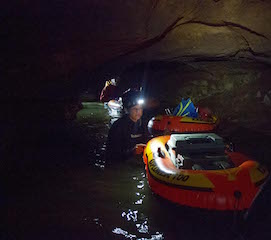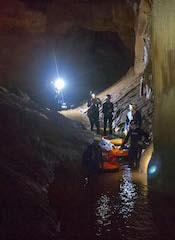 I recently worked as a camera operator on a VR feature called The Spring. The first question of many questions that I had for Greg Passmore, owner of Passmore Labs, Austin, Texas was, “When you are shooting a 3D 360 degree VR movie in a cave where at times you are perilously close to the top of the caves due to the water level, where do you position the crew?” His reply threw me off guard. He said, “Anywhere I want.” It was then that he told me he was shooting with one Red Epic camera. The question then was, how?
I recently worked as a camera operator on a VR feature called The Spring. The first question of many questions that I had for Greg Passmore, owner of Passmore Labs, Austin, Texas was, “When you are shooting a 3D 360 degree VR movie in a cave where at times you are perilously close to the top of the caves due to the water level, where do you position the crew?” His reply threw me off guard. He said, “Anywhere I want.” It was then that he told me he was shooting with one Red Epic camera. The question then was, how?
The Spring is an action-drama filmed in 360 3D VR. Three female cave explorers set out, dropping down through a pit to a cave with an underground river. The seemingly harmless adventure turns deadly as the underground river suddenly floods and the spelunkers are forced to go deeper into the labyrinth of caves to make their escape via the Spring, a rumored but unexplored exit.
Passmore realized two things during the pre-production process of the film. First, this story would make a fantastic virtual reality movie. Second, it would be impossible to shoot this with a traditional multi-camera VR Rig. For one thing, the only place for the eight-to-ten member crew to go during a take would be underwater. For another, the near claustrophobic tiny crawl spaces that would need to be navigated would simply not accommodate the VR Rig.
For Passmore, the obvious answer was, with such a controllable space, to shoot everything in panels.
 Passmore Labs is an awarding winning studio, working in the world of 3D multi-camera and 3D conversion. So Passmore is no stranger to inventing his own workflow and, in this case, creating his own proprietary spherical compositing software to stitch the elements of the eight camera views together. Don't think for an instant this was an easy process, lens calibration and filling in areas and warp correction, are just a few of the hurdles that needed to be overcome.
Passmore Labs is an awarding winning studio, working in the world of 3D multi-camera and 3D conversion. So Passmore is no stranger to inventing his own workflow and, in this case, creating his own proprietary spherical compositing software to stitch the elements of the eight camera views together. Don't think for an instant this was an easy process, lens calibration and filling in areas and warp correction, are just a few of the hurdles that needed to be overcome.
The next challenge was lighting in a water-filled confined space. In order to achieve a film quality dynamic range in the shots would require a delicate balance. They needed to be intensely bright and there really wasn't any place to out them. Actual caving lights emit a very low lumen light, insufficient for filming. The only choice was to create their own caving lights. The actors actually wore them on their heads. Extra planning went into the direction of the actors to not only deliver their lines but to also properly light the scene.
 I asked Passmore about using Super Speed Zeiss Lenses, but he said they needed a deep depth of field that those lenses don't offer. He needed to be able to stop down 2 1/2 to 3 stops to achieve the proper near infinite depth of field. I used a variety of lenses. Everything from the Peleng fisheye to the Zeiss Super Speed 35 (since we do panels).
I asked Passmore about using Super Speed Zeiss Lenses, but he said they needed a deep depth of field that those lenses don't offer. He needed to be able to stop down 2 1/2 to 3 stops to achieve the proper near infinite depth of field. I used a variety of lenses. Everything from the Peleng fisheye to the Zeiss Super Speed 35 (since we do panels).
Audio presented another complex set of challenges. Keeping the microphones dry, for one. Plus the acoustics of a water-filled cave are far from ideal. Special waterproof cases were utilized with small inflatable boats.
As for DIT, Passmore has a mobile production trailer/studio that he takes on location. The software has reached the point where he can ingest the raw files natively. Then the composite is built with the exported files feeding into an Oculus Rift for reviewing the days' shoot.
The footage is being turned into VR movie by using software (PAM360) especially written for this process. Passmore has been developing this software, with his team, for almost a year. PAM360 will be distributed by startup Poison Apple Media.
The principal photography is complete, with B-roll expected to be completed very soon.
Post is being handled at Passmore Studios in Austin, Texas. They have not finalized distribution; this is such a rapidly changing landscape. As of now the official planned release will take place in June at the Electronic Entertainment Expo in Los Angeles.
The finished film will be two versions, a ten-minute version and a three-minute version. Right now with VR that is feature length. Longer and more involved features will most likely follow as the technology moves forward. The complexity of longer VR movies and the ability for the audience to stay immersed are still questions yet to be answered. Time undoubtedly will tell.
Passmore summed up his rationale this way: “If we start with something hard, and survive it, we can then say, all right, great, now we can do the easy stuff. I really wanted to try something with some teeth, and this particular film was challenging because the physical environment as well as the filming issues. If VR really has this ability to create this intimate sense of space and feeling, then this was the perfect environment to show that off.”
